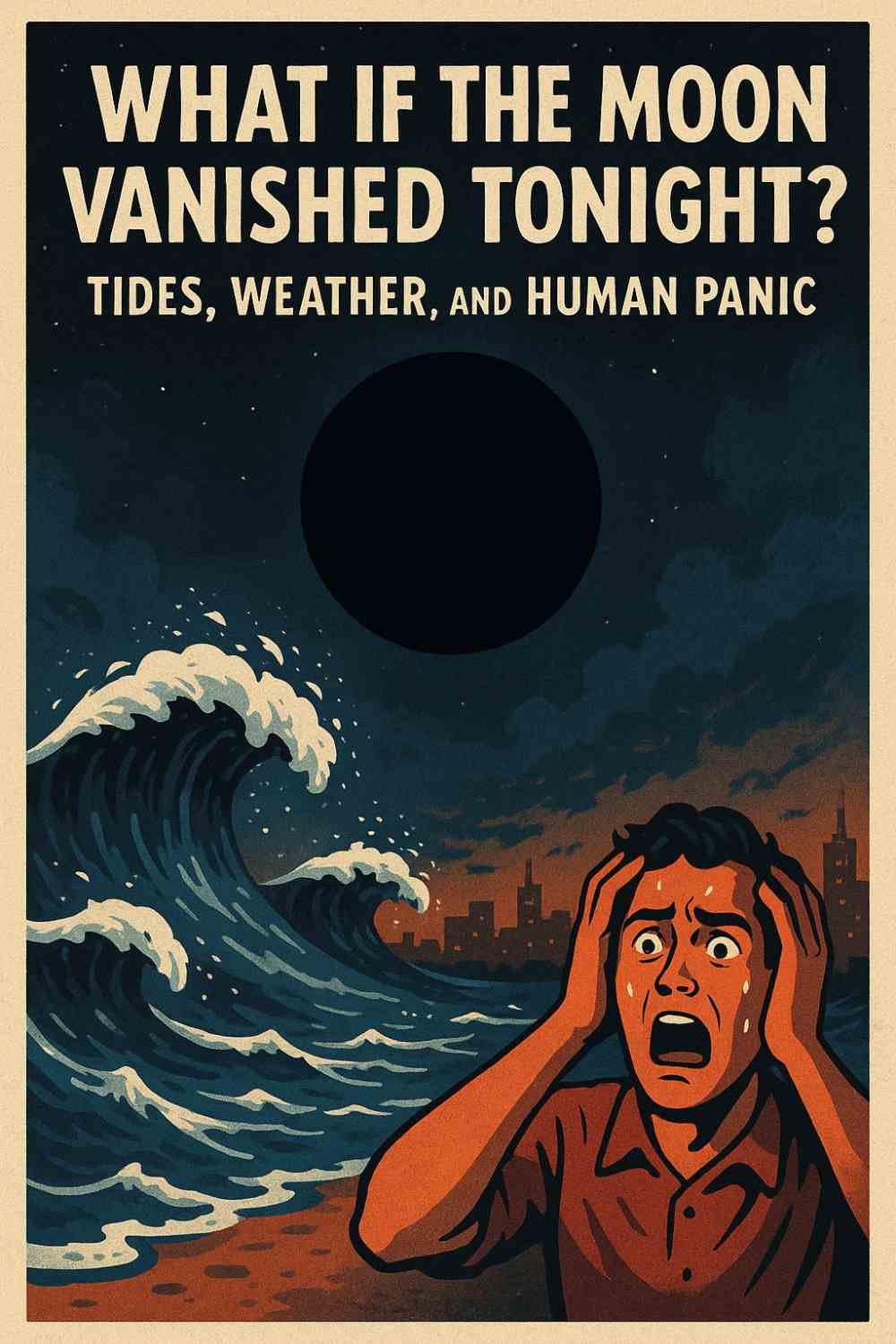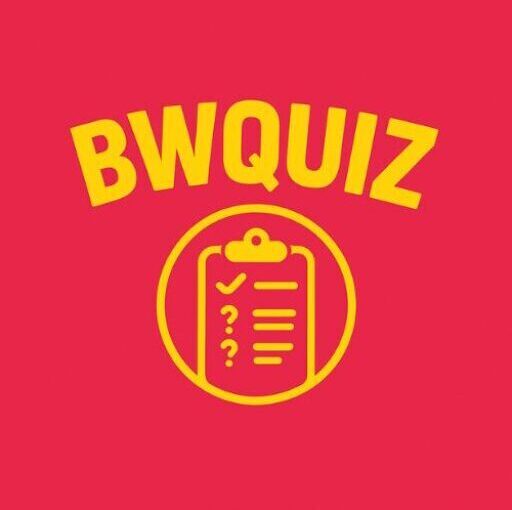What If the Moon Vanished Tonight? Tides, Weather, and Human Panic
🌑 The Moment After: What Changes First (and What Doesn’t)
Picture this: 8:00 PM, skies are clear, and… no Moon. Not behind clouds. Gone. Your eyes would notice it immediately; the night feels deeper, flatter, like someone dimmed the world’s nightlight. But Earth doesn’t lurch. The ground doesn’t heave. Your clocks keep ticking.
 Here’s the counterintuitive bit: gravity is fast, but oceans are sluggish. Remove lunar gravity and you don’t get a world-spanning tsunami; you get the sudden absence of a steady tug that used to raise and move vast volumes of water. The ocean, with all its inertia and geography, keeps sloshing on the rhythms it knows—then slowly settles into new ones. Think of it like abruptly turning off a fan: the blades spin for a while, then wind down.
Here’s the counterintuitive bit: gravity is fast, but oceans are sluggish. Remove lunar gravity and you don’t get a world-spanning tsunami; you get the sudden absence of a steady tug that used to raise and move vast volumes of water. The ocean, with all its inertia and geography, keeps sloshing on the rhythms it knows—then slowly settles into new ones. Think of it like abruptly turning off a fan: the blades spin for a while, then wind down.
In the first hour:
📖 Star fields are startlingly crisp. The sky is darker, which astronomers would quietly cheer.
📖 Tide tables go from useful to wrong. The water is where it was trending… until those trends stop making sense.
📖 No “gravity quake.” You don’t feel a physical jolt; the change is in forcing, not in an impulse.
🌊 Tides Without the Moon: How Much Shrinks, How Fast?
On average, lunar gravity contributes the dominant share of tidal forcing. Remove it and you’re left with the Sun, whose tidal pull alone is weaker. The quick translation for coastal life: typical tidal ranges drop dramatically—often to a fraction of what you’re used to—though the exact number at your local beach depends on basin shape and resonances.
What that means in real life:
📖 Ports designed around strong tidal cycles suddenly see shallower, lazier tides. Cargo timing, ferry schedules, and fishing strategies all misfire.
📖 Intertidal ecosystems (mudflats, salt marshes, mangroves) lose their twice-daily pulse. Expect stress, then re-sorting: some species retreat, others fill the gap.
📖 Clam diggers, seaweed harvesters, and any livelihoods tied to precise low tides hit a wall of uncertainty.
Not tonight—over weeks to months: coastlines will evolve new equilibrium patterns. Some places become nearly “microtidal.” Others keep meaningful swings driven by the Sun and local resonances. But that regular, familiar beat? It’s gone.
🌬️ Weather Tonight vs. Climate Long Game
Tonight: the wind doesn’t care. Storms don’t suddenly intensify because the Moon took a cosmic sick day. Day-to-day weather runs mostly on solar heating, ocean heat content, pressure gradients, and terrain. You still need a jacket if the forecast said so.
Over years to centuries: tides aren’t just beach theatre; they’re a mixing engine. Weaker tides mean slightly less stirring of coastal waters, fewer nutrients kicked up for plankton, and a slow tilt in the food web. That can ripple into fisheries, dead zones, and carbon uptake. It’s subtle, not cinematic—but in climate, subtle stacked over time becomes destiny.
🐠 The Biological Clock: Nature’s Night Shift Loses Its Metronome
The Moon is a clock in disguise. Lots of life reads it—some literally.
📖 Coral spawning often keys to lunar cycles. Take away the Moon and timing cues go dim. Corals may scramble, then adapt to other signals (temperature, day length), but expect messy transitions.
📖 Nocturnal hunters and prey adjust their risk calculus to moonlight. A permanently “new moon” night means predators that rely on sight take a hit; prey might venture out more. Over seasons, behavior rebalances, but not without winners and losers.
📖 Migratory cues (from birds to sea turtles) sometimes use a blend of starlight, horizon glow, and lunar phases. Remove one pillar and you force a rewrite of old instincts.
💡 Takeaway: ecosystems run on layered signals. Pull one layer, the system wobbles, then rebuilds. But the rebuilding can prune species and rewrite local abundance.
🧠 Human Panic: Markets, Myths, and Midnight Reasoning
In the age of social feeds, the first tidal wave would be psychological. Rumors of “Earth’s doom” would outrun any water. Expect:
📖 Emergency hotlines jammed with “is this safe?” calls.
📖 Markets reacting to uncertainty—shipping, fisheries, coastal tourism, even insurance.
📖 Misinformation sprinting laps around explanations. (You can already hear the “crop failure tomorrow” videos.)
Now the sober truth: nothing apocalyptic happens tonight. Lights stay on. Planes land. Bread rises. But systems built on predictability—ports, tidal energy, aquaculture—take an immediate punch.
🧭 Calendars, Culture, and the End of “Month”
The word “month” is a fossil of the Moon. Without phases, all lunar calendars break overnight. Rituals keyed to full moons lose their schedule. Astronomy apps push emergency updates. It’s a quiet cultural shock: poetry, art, song—centuries of moon-soaked metaphors suddenly echo without a source.
Practicalities stack up, too:
📖 Religious and cultural festivals tied to lunar phases need new rules.
📖 Night navigation in remote places gets harder. Moonless nights are darker than most urban dwellers remember.
📖 Wildlife safety on roads changes. Fewer bright nights may slightly reduce certain animal crossings… or shift them to dawn.
🔭 Science, Satellites, and a Darker, Better Sky
Astronomers would step outside and cry a little—from joy. Moonless nights are immaculate. Deep-sky observations improve instantly, bringing fainter galaxies into reach even from mid-grade observatories. Space imagers benefit as well: no more lunar glare contaminating sensors on certain orbits.
But there’s a catch:
📖 Earth loses a modest impact “sweeper.” The Moon absorbs and perturbs some debris that might otherwise intersect Earth’s space. It’s not a superhero shield (Jupiter does more), but statistically the loss nudges the background risk up. Still small, still long-term.
🧮 Spin, Tilt, and Seasons: The Slow Physics That Matter
The Moon helps steady Earth’s axial tilt (obliquity) over geologic timescales. Without it, Earth’s tilt would remain the same for a long while, but its long-term wobble could widen. That doesn’t flip climates in a decade; it shifts the backdrop for millions of years. Summers and winters might become more extreme in some eras, milder in others, as the tilt wanders further than we’re used to.
Two more quiet shifts:
📖 Precession (the slow wobble of Earth’s spin axis) changes pace without lunar torque, which tweaks long-term climate cycles.
📖 Day length keeps drifting, but more slowly. The Moon’s tidal braking has been fractionally slowing Earth’s spin; remove it and that braking eases.
None of this touches your weekend weather. It does matter to the deep history future—ice sheets, deserts, and ecological ranges painting different maps across epochs.
🏙️ Coastal Cities and Money on the Line
Where humans feel it fastest is where infrastructure meets water.
✅ Ports with hazardous tidal currents could see safer, steadier entrances in the long run.
❌ Tidal energy projects lose their business case. Some go dark immediately.
❌ Wastewater and stormwater systems tuned to predictable low tides get cranky. Backflow risks change, and so do windows for safe discharge.
✅ Flood risk from ordinary high tides might ease in some towns—but don’t confuse that with storm surge. Hurricanes and cyclones still push water hard, Moon or no Moon.
💡 Real planning problem: many coastal economies are built on the rhythm, not just the height, of tides. Reset the metronome, and a thousand small schedules break.
🗓️ The Timeline: From Tonight to the Next Century
Tonight (hours):
📖 The sky is darker; stargazing pops.
📖 Tide predictions skew; captains and harbor masters switch to live readings.
📖 Social panic, hot takes, and “end times” livestreams abound.
This week (days):
📖 Fisheries and intertidal workers report misses and weirdness.
📖 Wildlife cameras show altered night activity.
📖 Astronomers post their best images in years.
This year (months):
📖 Ports rewrite operating windows; insurance models update.
📖 Some coastal ecosystems suffer; others adapt.
📖 Cultural calendars decouple from phases and pick fixed dates or solar markers.
This century (decades):
📖 Ocean mixing’s subtle reduction shows up in regional productivity.
📖 Long-term climate cycles adjust pace without lunar torque.
📖 Humanity forgets what a “full moon night” felt like—except in paintings and old songs.
🧪 Sanity Check: Conservation, Physics, and “Vanishing”
Is it physically realistic for the Moon to just blink out? Not in any scenario that doesn’t break physics. But as a thought experiment, it’s useful. It isolates what the Moon does right now (tides, light, cultural timekeeping) from what it does over ages (stabilizing tilt, shaping climates). The practical lesson isn’t fear; it’s respect for how many quiet systems we depend on that are tuned to a gentle, persistent force 384,000 km away.
🔍 Want More Mind-Benders?
If this kind of “what if” gets your brain buzzing, test your curiosity streak with the ultimate Bing Homepage Quiz companion—a quick daily challenge that rewards deep trivia instincts. Or dive into more topics from space oddities to history quirks on our main quiz hub.
📌 Quick Answers to the Big Worries
📖 Will there be instant mega-tsunamis? No. The ocean responds, but without a sudden shove. Expect confusion, not catastrophe.
📖 Is tomorrow’s weather different? Not because the Moon’s gone. Weather runs on the Sun.
📖 Do tides vanish completely? No. Solar tides remain, typically much smaller—how small depends on your coastline.
📖 Are we doomed long-term? Doom is overplayed. The biggest changes unfold slowly, across generations to geological eras.
💡 Final Thought
The Moon doesn’t only give us pretty nights. It choreographs water, whispers to wildlife, steadies our seasons, and stamps our culture. If it vanished, we wouldn’t end—we’d relearn. Nature would rewrite some scripts. Humans would patch the rest with better data, new schedules, and a little stubborn ingenuity.
And maybe—on that first impossibly dark night—we’d all look up for a long time, not seeing the Moon, but finally noticing everything else.
